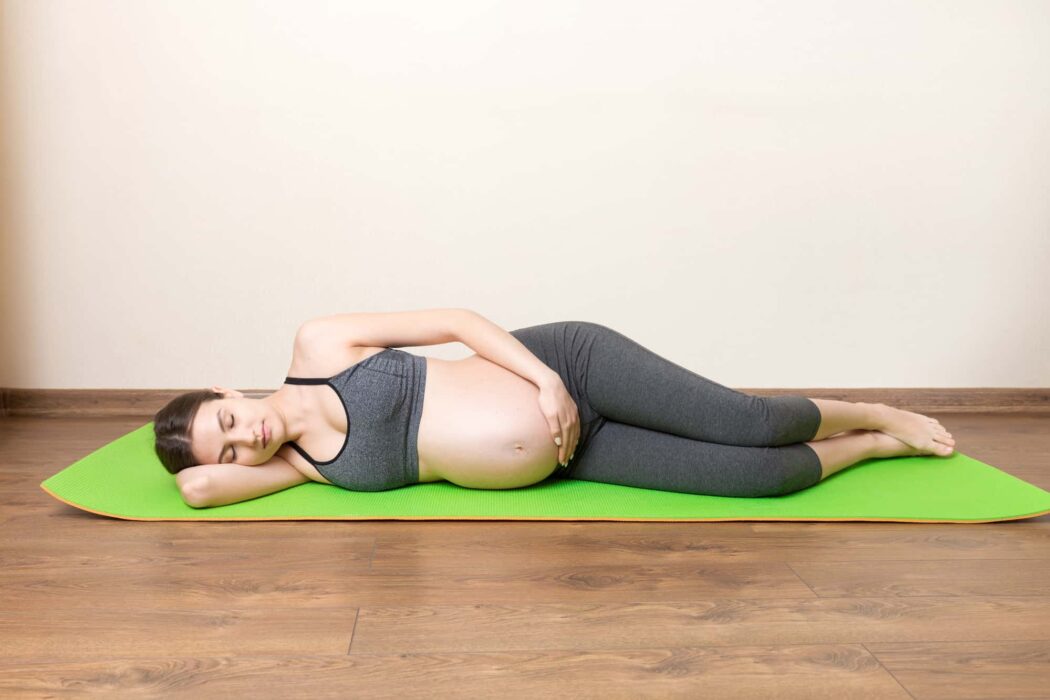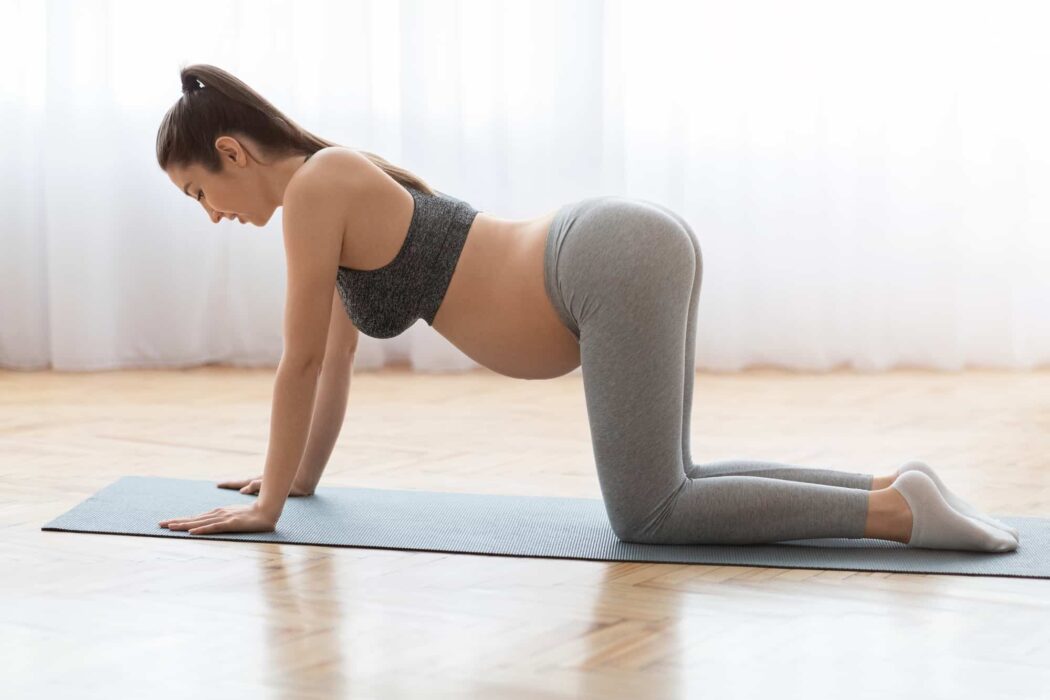During the entire period of pregnancy, you should not do:
- backbends from a lying position (these include, for example, Shalabhasana)
- complex balances (such as Bakasana)
- closed twists (for example, Marichiasana III)
- abdominal poses (like Navasana)
- inversions
Yoga practice for the prenatal period aims to relax the tension, reduce stress, and regulate the yogi mama’s emotional condition. It’s also a time to work on your breathing and prepare yourself for future labor and birth.
Yoga for Pregnancy: What to Avoid?
Upside Down and Balance
It is crucial for future moms who like to stand on their heads to exclude this posture from the practice during pregnancy. Honestly, this pose is not the easy one. It requires a certain amount of strength in the shoulders and arms. Also, in the headstand, the neck is loaded, and, of course, the seven cervical vertebrae cannot support the increased body weight without consequences. Falling off this posture can be lethal to your unborn kid.
Due to the increased abdomen, the body’s gravity center shifts, and your balancing skills can be compromised. Thus, avoid complex balancing postures. Replace them with supported balance using a wall or chair for more stability and safety.
Avoid:
- Shoulderstand
- Handstand
- Plough Pose
- Headstand
Belly Work
Exercises such as vacuum (or Uddiyana bandha), belly wave (or Nauli) should be avoided when pregnant. At the begging of your term, these can provoke uterus tone or a miscarriage and premature birth at the later stages.
Lying down on your belly will become more and more challenging as your move through your pregnancy. A baby growing inside you squeezes the organs, and any extra load on your abdominal muscles can be harmful to you and your child.
Avoid:
- Swan Pose
- Cobra Pose
- Bow Pose
- Locust Pose
- Seated Forward Bend
Twisting
Closed twists affect your abdominal region’s blood circulation and can cause compression. Avoid compressing the baby’s space to keep it protected.
*Open twists are ok if you are not in a high-risk pregnancy.
Avoid completely:
- Twisting chair and crescent
- Revolved triangle and half-moon
- Any seated twists
Still, you can use isometric moves instead like plank, extended table, forearm, or side plank. Strong core muscles can prevent lower back pain and build the endurance necessary for giving birth.

Overstretching
Pregnant women have an increased level of the hormone relaxin, which causes relaxation of the pelvic ligaments and joints. It is responsible for its expansion and normal childbirth. Your joints and muscles become even more flexible, so involving in dynamic or deep stretches, you risk overstretching the ligaments, resulting in strains and sprains and chronic pain.
Why Yoga Breathing Is Important?
Deep Backbends
Exercises with a backbend are allowed only for those who have mastered them well before pregnancy. Going into a deep backbend during pregnancy, you risk getting diastasis recti (the separation of abdominal muscles).
Avoid:
Prenatal Yoga Poses and Tips by Trimesters
In different periods of pregnancy, the need for physical activity and rest and the balance between those two will vary.
First Trimester
You may feel exhausted and at low energy, so ensure proper recreation. Also, this is the period when the embryo implantation process finishes, and it starts to grow. Thus, it’s better to avoid active jumping and fast-paced flows. Instead, devote more time to light pranayama and meditation, as well as restorative and grounding yoga postures.
Asanas performed lying on the stomach and on the back can be done only in the first trimester and with precautions.
When Should I Start Yoga in Pregnancy?
For those who literally just got the idea to do yoga to improve their well-being during pregnancy, it is better to postpone classes until the 2nd trimester – at least until the 13th week.
In the case of IVF, postpone until the 20th week – and start only if the pregnancy goes on without complications.
If you have an established pre-pregnancy practice – you can proceed with the exercising as long as it feels good to you. Still, it’s compulsory to adjust your routine accordingly and consult with your ob-gyn.
Is It Safe to Do Yoga in First Trimester?
The fact is that the 1st trimester is a potentially dangerous time. During this period, a more significant number of miscarriages occur. There is no evidence that physical activity can cause termination of pregnancy, but it is better to play it safe.
Do not forget that the first trimester is a period of active development of the fetus, forming all vital organs. Therefore, deciding to do prenatal yoga, be sure to consult with a specialist.
Second and Third Trimesters
Between 13 and 28 weeks, your hips, joints, and lower back undergo increased loads. So strengthening muscles and developing hip joints in this period helps to get in the “birth prep” mode. Your tummy starts to go bigger, and many postures will require adjustments with this in mind.
Why Yoga Is Good? 5 Unique Yoga Benefits Proved with Your Anatomy
From the third trimester, common asanas will be difficult or uncomfortable to do; therefore, use any equipment or improvised materials (pillows, bolsters, blankets, etc.) to support the body during practice. Focus on hip opener and lunges. They will help you open up and strengthen the pelvic floor.

Do Savasana not on the back, but lying on the side. Concerning pranayama, use simple variations of Ujjayi and Viloma performed from a seated position.
Can Yoga Cause a Miscarriage?
Each pregnancy is specific; sessions should also take into account the health condition of yogi mama. Failure to comply with the prenatal yoga precautions and restrictions will reduce yoga’s positive effect and lead to unforeseen complications.
How Can I Do Yoga at Home during Pregnancy?
Important: if you have not done yoga before, in no case, start the practice on your own. For the first time, work with a licensed instructor who will explain some of the tricky exercises and make sure you get them right.
Preparation for a yoga session becomes an essential factor that ensures the comfort of the yogi mom, the security of the unborn kid, and the effectiveness of the classes. Follow these guidelines:
- Empty your bladder before exercise and do not overeat; exercising on a full stomach is harmful to mom and baby;
- No sudden moves. Practice smooth sequences and transitions so as not to harm the fetus;
- Make sure your clothes allow free movement and aren’t synthetic;
- If you feel like taking a break during a class – do it!
Some safe yoga postures for all trimesters include:

- Cat-cow
- Tree pose
- Butterfly pose
- Hero’s pose
- Triangle pose
- Legs up the wall
What Other Yoga Types to Avoid?
Hot or Bikram yoga is prohibited, as well as active yoga flows and power styles that result in the rise of heart rate and body temperature – this is unacceptable during pregnancy.
These simple rules and precautions ensure comfort and safety for your child and make your yoga practice joyful for both of you. Go gentle on yourself! Be mindful of your changing body and don’t push yourself over the limits: pregnancy is not the best time to do it. Take care, yogi mama:)